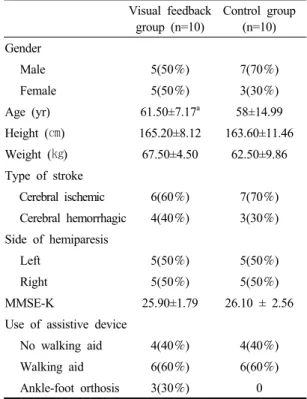| Abstract |
Purpose: This study aimed to investigate the effect of visual feedback training—for gradual weight shift in sit-to-stand training—
on the balance and walking abilities of chronic hemiplegia patients.
Methods: Twenty patients with chronic hemiplegia volunteered to participate in this study. The experimental group received visual feedback for gradual weight shift in the sit-to-stand training, while the contrast group followed the standard process for the sit-to-stand training. The evaluation of the balance and walking ability was conducted with the functional reach test (FRT), Berg balance scale (BBS), five time sit-to-stand (FTSTS) test, timed up and go (TUG) test, 10 m walk test (10MWT), balancia, activities-specific balance confidence (ABC) scale, and falls efficacy scale (FES).
Results: In the results before and after intervention, there was a significant difference in TUG, 10MWT, ABC, and FES in the visual feedback training group (p < 0.05). In the control group, there was a significant difference in the 10MWT and ABC (p <
0.05). Also, in the evaluation of the postural fluctuations, the control group data showed a significant increase in Covar. The visual feedback group showed a significant difference in the W average.
Conclusion: The visual feedback training group showed some improvement in terms balance and walking ability and on the ABC scale and FES. Therefore, if the diagonal progressive weight bearing exercise is combined with the various patterns and basic principles of PNF, it may be a more efficient intervention method.
Key Words: Sit to stand, Weight shift, Visual feedback, Balance, Walking
†Corresponding Author : Kyung-hwan Kim (ejptkh@hanmail.net)
Original Article Open Access
앉고 일어서기 동작에서 점진적 체중 이동을 이용한 시각적 되먹임 훈련이 만성 편마비 환자의 균형 및 보행능력에 미치는 영향
김경환
†⋅박성훈⋅김형민⋅박노욱⋅김다연
11)보니파시오병원 재활센터,
1대구대학교 물리치료학과
Effect of Visual Feedback Training for Gradual Weight Shift in the Sit-to-stand Training on the Balance and Walking Abilities of Chronic Hemiplegia Patients
Kyung-hwan Kim
†⋅Sung-hoon Park⋅Hyung-min Kim⋅Noh-wook Pak⋅Da-yeon Kim
1Bonifacio Hospital Rehabilitation Center
1

